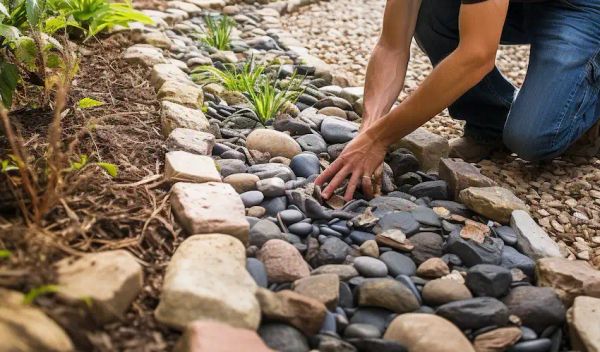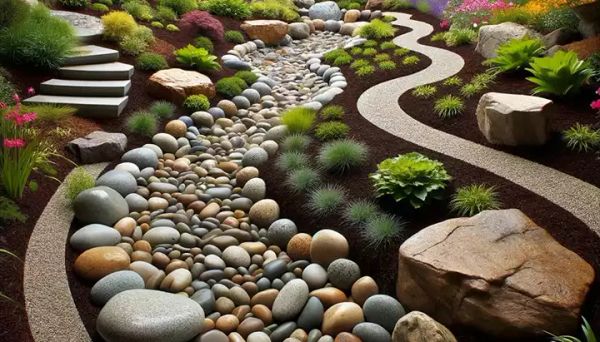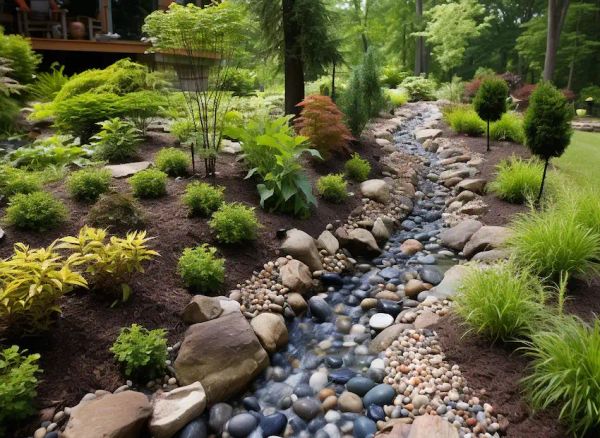Imagine transforming a section of your garden into a tranquil dry creek bed. Not only will it add a touch of serenity and beauty to your outdoor space, but it will also serve practical purposes like improving drainage and preventing erosion. In this step-by-step guide, we will show you how to create your own dry creek bed.

Step 1: Plan Your Design
1.1. Choose the Perfect Spot
Take a walk around your garden and find the ideal location for your dry creek bed. Look for naturally low areas where water tends to accumulate or areas where you want to redirect excess water.
1.2. Design with Nature in Mind
Sketch a rough design on paper, keeping in mind a natural look. Consider curving lines to mimic the meandering flow of a stream. Vary the width of the creek bed along its course for a more realistic appearance.

1.3. Know the Rules
Before you begin, it’s important to check with your local zoning office for any regulations regarding water redirection or landscape changes. This will help you avoid any unnecessary setbacks.
Step 2: Mark and Dig the Creek Bed
2.1. Mark the Area
Using landscape paint or a hose, mark the outline of your creek bed on the ground. This will help guide you as you start digging.

2.2. Start Digging
Grab your shovel and start digging along the marked lines. Aim for a depth of about 2-3 inches for smaller creeks and up to 6 inches for wider sections. Gradually slope the sides to create a natural look.
2.3. Create a Gentle Gradient
If your yard is flat, create a gentle gradient to direct the flow of water. A slope of about 1-2% is usually sufficient.

Step 3: Lay the Foundation
3.1. Stop Weeds with Landscape Fabric
Lay landscape fabric along the bed to prevent weed growth. Make sure it covers the sides of the creek bed as well.
3.2. Use Edging for Perfection
To keep the rocks from mixing with the soil, install edging materials such as metal or plastic along the sides of your creek bed. This will give it a neat and clean look.
Step 4: Add Rocks and Boulders
4.1. Bigger Rocks First
Start by placing larger boulders or rocks throughout the creek bed. Distribute them irregularly, just like you would find in a natural stream.
4.2. Fill the Gaps
Use smaller stones and gravel to fill in the spaces between the larger rocks. Vary the size and color of the stones to create a more natural appearance.
4.3. Secure Everything in Place
Make sure all the rocks are firmly placed so they won’t move when stepped on. This will ensure that your dry creek bed stays in place and looks beautiful.
Step 5: Enhance the Surroundings
5.1. Choose Native Plants
Plant native shrubs, grasses, and flowers along the edges of your creek bed. This will integrate your dry creek bed with the rest of your garden. Select plants that naturally grow near waterways in your area for a cohesive and harmonious look.
5.2. Add Mulch for the Finishing Touch
Apply mulch around the plants to retain moisture and suppress weed growth. This will help your dry creek bed and surrounding plants thrive.
Step 6: Maintenance
6.1. Watch for Erosion
After heavy rains, check for signs of erosion or displacement of rocks. Make any necessary adjustments to maintain the integrity of your dry creek bed.
6.2. Weeds and Pruning
Regularly remove weeds and prune any overgrown plants to keep your dry creek bed looking its best. This will ensure that it continues to be the highlight of your garden.
Creating a dry creek bed in your garden is both a rewarding and practical project. By following these detailed steps, you can enhance the beauty of your outdoor space while preventing erosion and improving drainage. Take your time planning and constructing your creek bed, and enjoy the process of creating your own natural oasis. Share this guide with your friends and inspire them to transform their gardens too!




